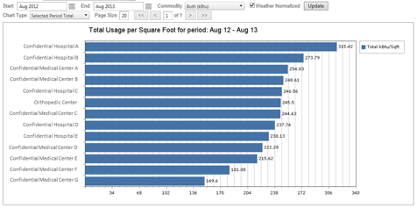
The Tools You Need to Support Facilities Management Benchmarking
Ma-Keba Frye | October 23, 2020 | Data & Technology | Energy & Sustainability
Facilities management benchmarking – the process of measuring a building’s energy use over a certain period – plays a critical role in an effective energy management program. But between changing benchmarking compliance requirements and new challenges created by the pandemic, energy and facility managers may have a tough time getting a handle on compliance. Read on to get a better understanding of the demands of modern building benchmarking – and see how the right technology can help you comply with ease.
Benchmarking in the era of COVID
Utility usage trends have changed dramatically as more people stay at home during the pandemic. Between February and April, U.S. households saw a 21 percent spike in water usage as consumers worked from home and paid more attention to handwashing. As a result, cities and states that have not yet implemented water benchmarking requirements are likely to begin doing so in the near future.
Between February and April, U.S. households saw a 21% spike in water usage as consumers worked from home and paid more attention to handwashing.
Although many states provided an initial grace period for submitting benchmarking data due to the pandemic, the delays could only last so long. As facility operating hours change and fewer employees are allowed onsite, ENERGY STAR implemented new guidance for benchmarking and certification, opening the door for organizations to continue to meet the requirements amid new circumstances. With all this in mind, there are a few key steps energy and facility managers can take to stay on top of compliance and drive measurable savings.
Use data that you can depend on
The backbone of any energy management program is accurate and reliable data. You’ve probably heard this before, but not all data is created equal. For data to be useful and actionable, it needs to be organized and normalized to establish an accurate baseline. To create this baseline, you need to compare each performance metric against various time periods and similar peer groups to understand what steps, if any, need to be taken.
READ MORE >> HOW TO ENSURE A SUCCESSFUL ENERGY MANAGEMENT PROGRAM
The first step in the benchmarking process requires continuous access to monthly utility bill data, which can often be such a cumbersome task that benchmarking programs commonly fail at this first stage. To streamline this step, implementing an automated tool like the Urjanet Utility Data Platform can help you get easy access to granular, timely, and accurate data every month.
Establish a tracking process
To manage anything, you have to be able to track it. Establishing an efficient and repeatable tracking process for your utilities is an important order of business when creating an accurate benchmarking program. According to the Institute for Market Transformation, “benchmarking is the foundation of effective energy management and is quickly becoming an operational best practice of the commercial real estate industry.”
Tracking utility bill data can reduce a building’s energy consumption by an average of 2.4% annually.
A review by the Building Owners and Managers Association (BOMA) found that continuously tracking utility bill data can reduce a building’s energy consumption by an average of 2.4 percent annually. In addition to monetary savings, the improved visibility into usage and cost patterns from benchmarking can help you answer important questions like:
- Can I reduce my peak demand?
- If I reduce usage at certain times, will I qualify for a better rate?
- Should I schedule automated cooling and heating temperature bands to control peaks and troughs in my usage?
Implement a reliable benchmarking tool
Having the right software tool on hand is critical to running a successful benchmarking program. Facility benchmarking tools like THG Energy Solutions can give facility managers a quick snapshot of their facilities using the most up-to-date energy data. They can also provide a comparison of baseline to current performance, as well as compare facilities to one another based on set metrics. Using data-based applications, THG can quickly and affordably:
- Reveal poor energy performers and savings opportunities across all your facilities
- Establish a baseline and identify outliers to expose energy problems
- Present you with the opportunity to take the first step toward informed business decisions to improve your bottom line
Example image of a THG benchmarking dashboard
Improve facilities management benchmarking with Urjanet and THG
Organizations that prioritize energy management can reduce operating expenses, increase their portfolios’ asset value, and demonstrate their commitment to the environment. Urjanet in partnership with THG removes the hard work from getting started in facilities management benchmarking. We’ll take data wrangling and management, automated utility invoice collection, and tools for reporting and visualization off your plate so you can focus on meeting compliance requirements and driving savings with ease.
To learn more about how Urjanet and THG can help you automate and streamline facilities management benchmarking, speak with one of our data experts today.
You might also be interested in:
- How to Ensure a Successful Energy Management Program
- eBook: Building Energy Benchmarking & Transparency Laws
- Considering ENERGY STAR Portfolio Manager for Your Organization?
If you like what you’re reading, why not subscribe?
About Ma-Keba Frye
Ma-Keba Frye is a Content Marketing Associate at Urjanet, assisting with content development and execution. When she's not writing, she enjoys reading, listening to music, and volunteering.
You May Also Like
5 Steps to Audit Utility Data Quality
Honor Donnie | June 10, 2022 | Data & Technology

